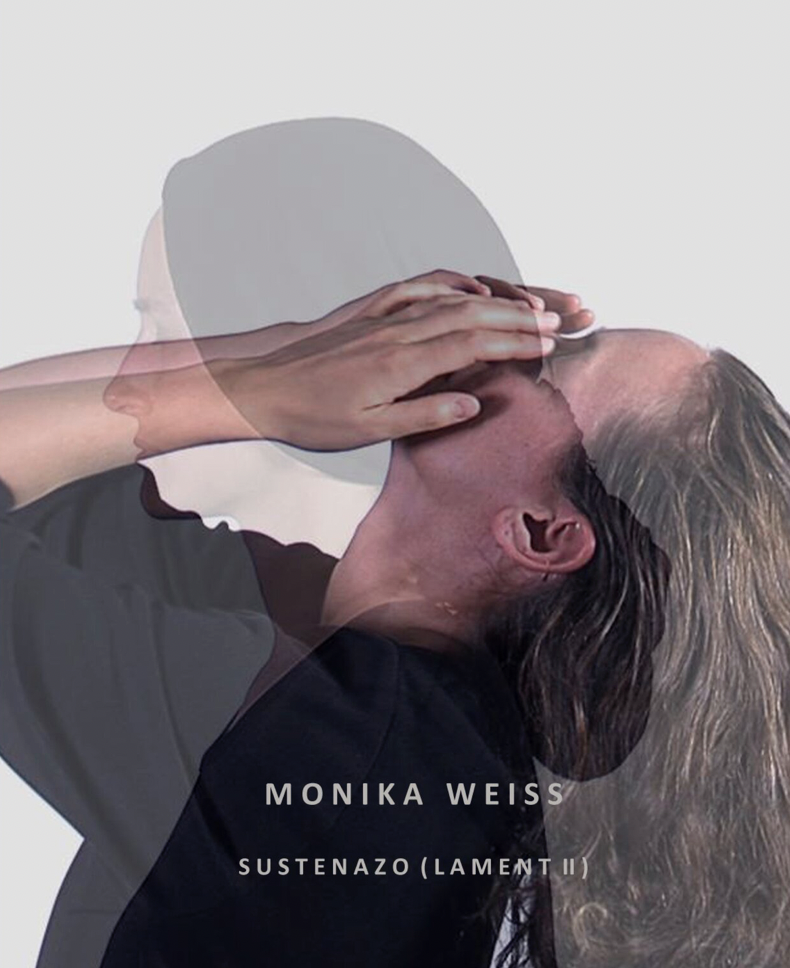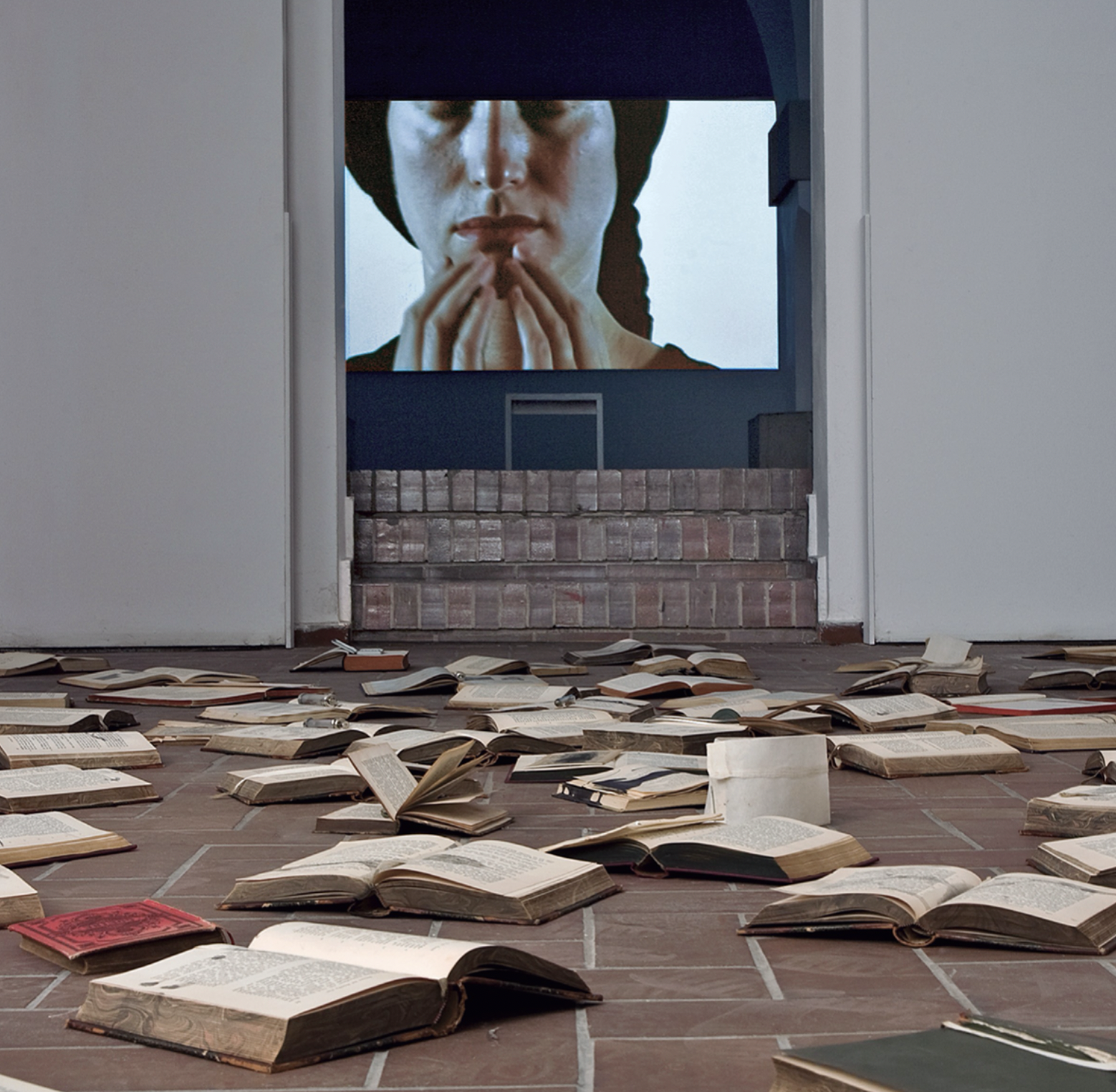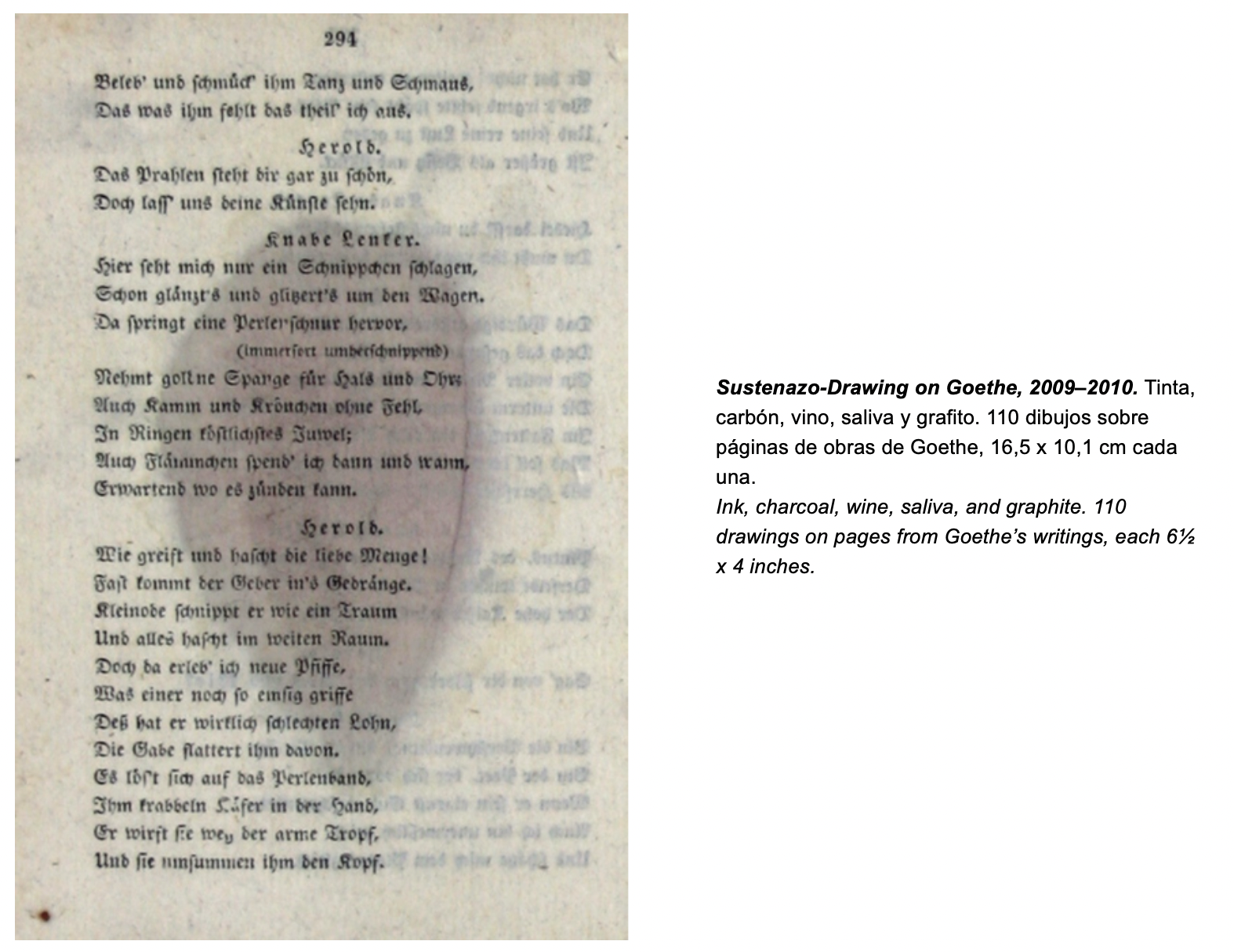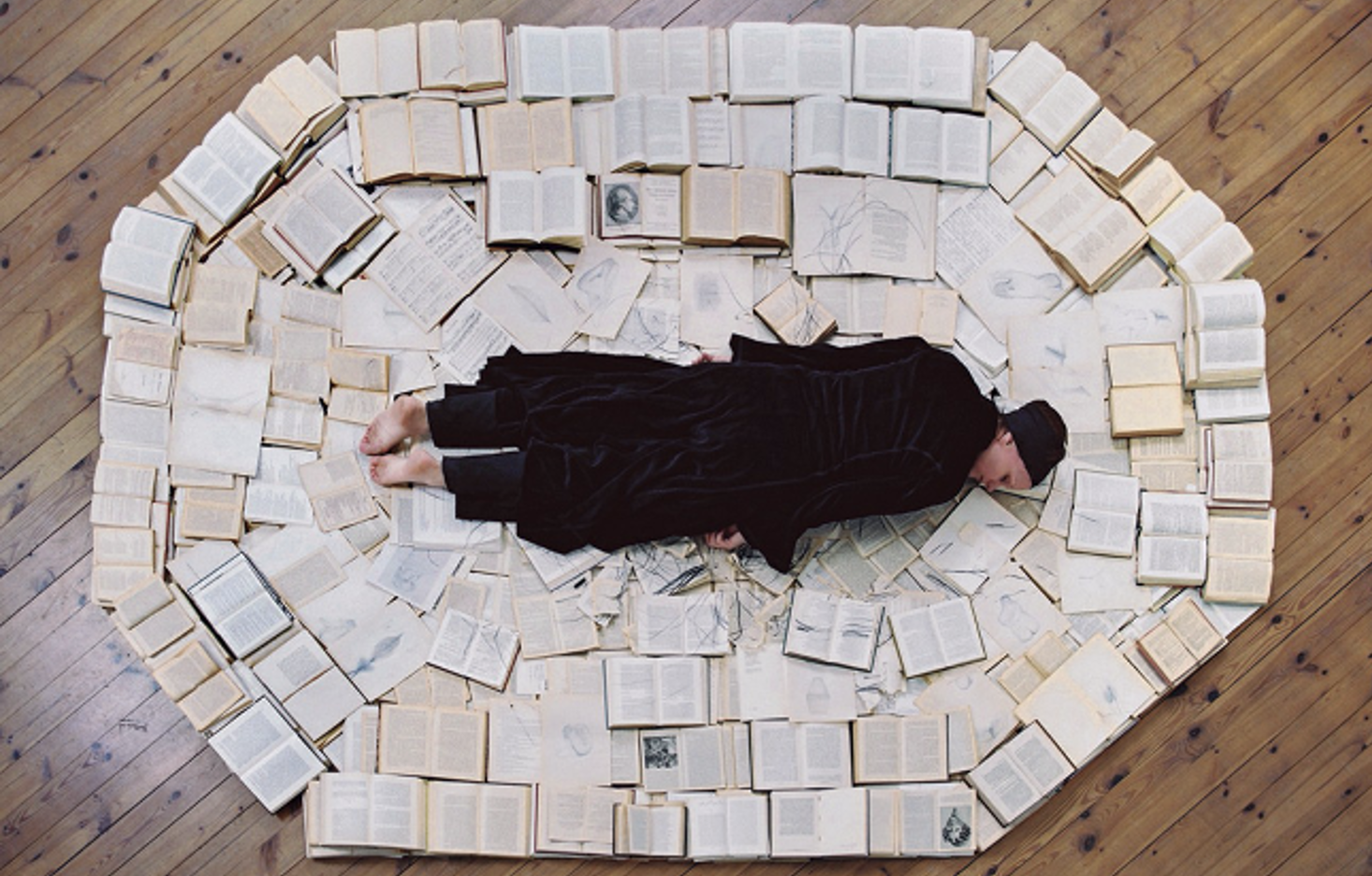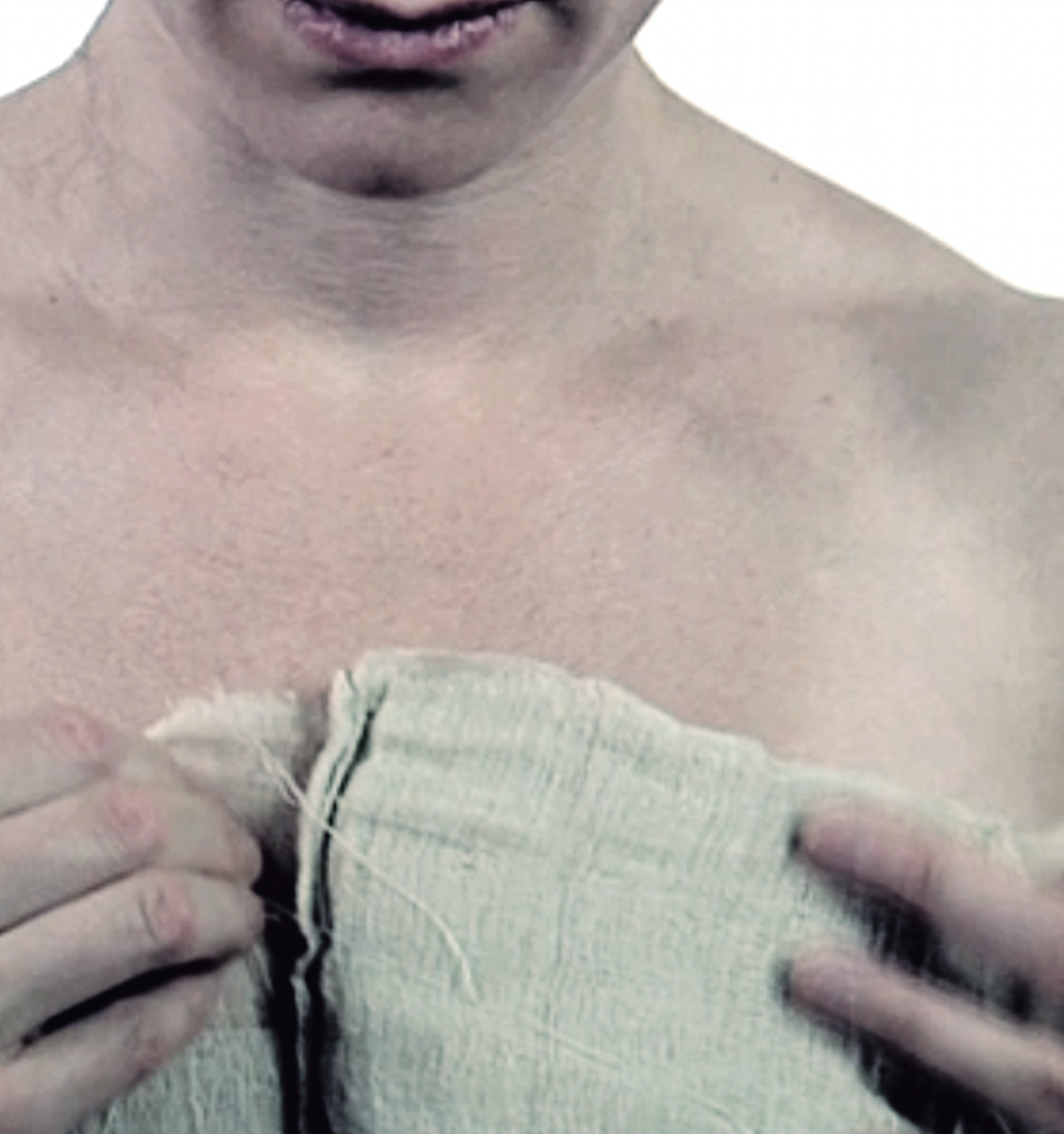julia p. herzberg (conversation)
A Conversation with Monika Weiss
in Monika Weiss-Sustenazo (Lament II), Museum of Memory and Human Rights, Santiago, Chile, 2012
Introduction
Sustenazo (Lament II) is one of three videos presented at the Centre for Contemporary Art Ujazdowski Castle (CCA) in 2010 in five contiguous galleries. The exhibition also included drawings, photographs, and an installation of vintage books, many with the artist’s drawings, together with medical objects placed on the floor of one of the galleries.
The backstory of this project sheds light on the artist’s extensive research, which became the foundation for the conceptual transformation of the multilayered narrative of Sustenazo (Lament II). Monika Weiss was invited to do an exhibition by Milada Ślizińska, the former Chief Curator of the International Exhibitions at the Centre for Contemporary Art (CCA) in Warsaw and, as well, to be an artist in residence at the Artists-In-Residence Laboratory under the direction of the curator Ika Sienkiewicz- Nowacka.[1] During 2009 the artist did research both on-site and off-site beginning at the Ujazdowski Castle, where she became interested in the history of the Ujazdowski Hospital’s expulsion. Her research continued in the closed collections at the Central Medical Library in Warsaw and at the Warsaw Rising Museum, the Historical Museum of Warsaw, and Media in Motion in Berlin.
Weiss worked in the special collections division at the Central Medical Library, where she filmed damaged archival materials such as documents, letters, photographs, and medical instruments that had survived the Ujazdowski Hospital expulsion. At the Historical Museum of Warsaw, Weiss photographed German aerial military maps that had entered the museum’s collection some years after World War II. Many images in the Sustenazo project originated in the archives of these institutions. At Media in Motion, Weiss recorded the voices of German speakers reciting passages from Goethe’s Faust II, which became part of the final sound composition in Sustenazo. Monika Weiss directed, recorded, composed, and choreographed Sustenazo.
The following persons contributed to the production of Sustenazo (Lament II): the German voices in Part One are those of Kristina Hahn and Maja Linke; the Polish voice in Part One is that of Krystyna Zalewska; the countertenor in Part Two is Anthony Roth Costanzo; the German voices in Part Three are Barbara Caveng, Heiko Daxl, Andreas Matthias Grimm, Max Hannes, Anna Hope, Cordula Hufnagel, Ralf Niebuhr, Christoph Rasch, Bele Papperitz-Hannes, Wolfgang Strankowski, and Jens Umlauf. Gillian Lipton is the dancer in the video.
Sustenazo (Lament II) presented at the Museo de la Memoria creates a space that restores historical memory to the present.
Conversation
JULIA P. HERZBERG: Sustenazo (Lament II) is one of the three videos of Sustenazo (2010), a performative work that embraces history, memory, and language in overlapping rhythms and forms. Let’s talk about each of these subjects and their subtexts beginning with your relationship to history in general, its political dynamics, and to the particular event during World War II that in part inspired the project.
MONIKA WEISS: My understanding of history is that it is composed of parallel histories—it is never one history. Multiple histories coincide with each other and at times overlap. I believe there is a responsibility that comes with being an artist, which is in part poetic and in part political: to listen and to address the archive of events, paying special attention to the forgotten narratives and voices. The concept of nationalism, of any kind, does not interest me. Rather, I believe we need to pay attention to the global nature of oppressive systems and institutionally designed violence. Such violence is often justified by the ideology of “protection,” which usually veils hidden economic and colonialist agendas. Sustenazo developed around the notion of lament as a form of expression outside language: the timeless expression of lament is juxtaposed against the archive of a specific historical event —the forced overnight evacuation of Ujazdowski Hospital on the sixth day of the Warsaw Uprising in 1944. The historical background for this event is the invasion of Poland on September 1, 1939, which marks the beginning of World War II and, subsequently, the partition and annexation of Poland by Germany and the Soviet Union.[2]
JULIA P. HERZBERG: I know that your grandfather worked in the now historical Polish Post Office in Danzig (Gdańsk). On September 1, 1939, the day of the German invasion of Poland, civilian defenders fought for fifteen hours until the personnel in the different postal buildings surrendered. He was one of a handful of employees who escaped and was later captured and imprisoned in a concentration camp, where he died a year later.
MONIKA WEISS: The Defense of the Polish Post Office in Danzig (Gdańsk) was one of the first acts of World War II in Europe.[3] After the surrender of the Polish Post Office, forty postmen were captured, quickly tried, and executed by a Wehrmacht firing squad. My grandfather, Leon Knopik, a postal clerk, was captured soon thereafter, imprisoned, and taken first to Stutthof concentration camp, near Gdańsk, and then moved to Sachsenhausen-Oranienburg concentration camp,[near Berlin.[4] Some months after my grandfather’s capture, my grandmother, then pregnant with my mother, received a package from Sachsenhausen-Oranienburg with a letter explaining that my grandfather died in the camp “due to pneumonia.” The package contained his winter coat soaked in blood, which my grandmother washed carefully and gave to the first stranger she saw who needed a coat during that very cold winter of 1940.
JULIA P. HERZBERG: You grew up in the 1970s in Warsaw under a Communist regime. What were you formally taught about World War II in school, which I assume was taught through the Communists’ lens? What memories or experiences did your family relate, if any, about growing up during and after the war?
MONIKA WEISS: In primary school I was taught that the Soviet Union was Poland’s “brother,” and in the history books the Warsaw Uprising (also known as the Warsaw Rising) simply did not exist—the books were completely silent about it. In fact, mentioning the Uprising in public was forbidden.[5] As a child I learned about the Uprising from my parents who kept “illegal” (underground) history books and who listened to “illegal” news on the radio (Radio Free Europe/Radio Liberty). I learned that the Warsaw Uprising was a major World War II operation conducted by the Polish resistance to liberate Warsaw from German occupation, timed to coincide with the Soviet army’s arrival at the city’s eastern suburbs.
On July 29, 1944 the Soviets, through Moscow Radio Station Kosciuszko, broadcasted in Polish a call for the Uprising to begin, promising that the Soviet army would join the Poles in their fight against the Germans.[6] The Uprising began on August 1, 1944 and lasted for sixty-three days. Although the Poles established control over most of central Warsaw, the Soviets did not come to their aid. They remained on the other side of the Vistula River.[7]
JULIA P. HERZBERG: You have often spoken about memory and specifically the city’s memory in your work. How does a city’s memory play itself out in Sustenazo? Why does the subject of lamentation surface in relation to a city’s memory?
MONIKA WEISS: My recent work, including Sustenazo, considers aspects of public memory and amnesia in the construction of the space of a city and its urban planning. Maps of cities are flat, yet their histories contain vertical strata of events. Where in the topography and consciousness of a city can we locate its memory?
The body of a city may be compared metaphorically to our body and its memory. One of the manifestations of a city’s memory is its architecture, such as in the case of Warsaw. After the capitulation of the Warsaw Uprising, the Germans cleared the city of its remaining inhabitants; over the next three months, they set fire to the infrastructure of every neighborhood and later demolished those buildings that did not completely perish in the flames. All the while, the Soviet army remained on the other side of the Vistula, a very narrow river that offered a close-up view of what was happening in Warsaw as it became a landscape of rubble.[8]
To paraphrase Saskia Sassen, cities are potential spaces of resistance to military power: they are “weak regimes.” While cities cannot destroy power, they can contest it.[9] My recent project Shrouds (2012) focuses on a Polish city, Zielona Góra, which has forgotten parts of its own history. Current maps depict an empty unnamed, rectangular area located in the center of the city, which is covered with debris from destroyed buildings. During World War II this site was a small concentration camp for Jewish women.[10] In Sustenazo I juxtapose and overlay close-up views of a woman’s chest covered with surgical drawings, a 1942 German map of Eastern Europe, and my gloved hand smearing charcoal on the map. (See video still 15)
In Shrouds I also contrast and superimpose a close-up view of a woman’s chest covered with bandages together with contemporary aerial views of the former Gruenberg (Zielona Góra) concentration camp, now in rubble. The female body in these videos stands for an anonymous body, yours or mine, as if it were a membrane between the self and the external world.
JULIA P. HERZBERG: Does lamentation exist in the contemporary life of a city? And if so, what form does it take?
MONIKA WEISS: Our western society often sublimates mourning into other forms of expression or of memorials of different kinds. We use signs or plaques to commemorate genocides or holocausts; we have public prayers to mourn the deceased; we publish history books to remember the past, and we bring a fraction of the people responsible for those genocides to international tribunals. However, we are not accustomed to collective mourning in the form of ancient rituals of lamentation. Lament as an emotional reaction seems to be stigmatized by an association with the private sphere, and is thus considered inappropriate or shameful in public.
JULIA P. HERZBERG: So would you say that the public ritual of lamentation has become obsolete for all intents and purposes?
MONIKA WEISS: The language of public lament could offer a possibility for expanding our awareness of coexistence and responsibility for the Other. By enacting ancient gestures of lamentation, Sustenazo considers contemporary contexts of apathy, indifference, invisibility, and historical amnesia within the public forum and polis. Lament is extreme expression in the face of loss. Ultimately, as Judith Butler wrote, “grief furnishes a sense of political community of a complex order, and it does this first of all by bringing to the fore the relational ties that have implications for theorizing fundamental dependency and ethical responsibility.” [11]
Group mourning is an act of political force, and not only a response to individual grief. We should ask then, whose life is or is not worthy of grief? In the context of war, loss is often about the loss of the Other, but in reality the Other is also a part of oneself. Empathy and collective mourning, including mourning the loss of others who are supposed to be our enemies, can become a powerful political tool, in opposition to heroic, masculine fantasies of conquest and power.
JULIA P. HERZBERG: The body is a carrier of narratives. You filmed a woman performer whom you choreographed to express the gesture of lamentation. In this work, lamentation is a response to war and a metaphor for suffering. Tell us about the overlapping narratives.
MONIKA WEISS: In Sustenazo the timeless gesture of lamentation is confronted with the archive of a specific historical event—the forced overnight evacuation of the Ujazdowski Hospital’s eighteen hundred patients and staff on August 6, 1944. In Part I of the video, the woman appears as two persons moving in opposite directions— simultaneously presented in real time and reverse motion, thanks to video and film editing technologies. (See video still 2) Her body is present, although it exists outside of specific time. I choreographed and directed the performer’s movements.
Her slow-moving gestures of lamentation or mourning are at once theatrical and minimal. They do not tell a historical narrative: the viewer does not know the reasons for her mourning. Lament—performative and communal—becomes a shared emotional experience. I decided not to perform in Sustenazo (or in my other recent works) to avoid autobiographical interpretations. Sustenazo is not solely about Poland or Polish history or European history. It is more broadly about the loss of lives inflicted by war and by other political and organized acts of violence and oppression. For me, war is not only devastating: it is unacceptable.
JULIA P. HERZBERG: Why did you choose Goethe’s writing as one of the central elements in Sustenazo? Let’s begin with the texts and their meaning. At the beginning of the video there are two passages from Goethe, the second of which reads:
All that is transitory
is only a symbol;
what seems unachievable
here is seen done;
what’s indescribable
here becomes fact; [12]
MONIKA WEISS: This second passage in my video is one of two fragments from Johann Wolfgang von Goethe’s Faust, Der Tragödie zweiter Teil (Faust II) / Faust, Second Part of the Tragedy. This famous Chorus Mysticus is located at the end of the play. Goethe wrote Faust II sixty years after the first part of the Tragedy during the last year of his life (1831). The focus in the second part is no longer on the soul of Faust, which has been sold to the devil, but rather on social phenomena such as psychology, history, and politics, in addition to mystical and philosophical topics. I am interested in the complex relationship between two seemingly irreconcilable phenomena—high culture and genocide; and in this case, between Goethe’s symbolic heritage and the Holocaust’s modern system of oppression and cleansing. For example, my new project involves the famed Goethe Eiche (“Goethe’s Oak”) near Weimar, a tree under which Goethe used to sit and write. Around this tree, in 1937, Germans built the Buchenwald concentration camp,[13] one of the first and largest concentration camps on German soil.
Although an American bombing raid (August 24, 1944) damaged the Goethe Eiche, the Nazis carefully preserved the stump, which is still maintained today as part of the memorial at KZ Buchenwald. As noted by Goethe’s secretary, during the poet’s September 1827 visit to his Eiche, Goethe stated: “I have very often been in this spot, and as of late years I have thought…I should look down hence on the kingdoms of the world, and their splendor.” [14 ] According to Klaus Neumann’s Shifting Memories: The Nazi Past in the new Germany, one could consider Weimar’s main function as providing the stage for memorializing Goethe: “If one took ‘Goethe’ to be a shorthand symbol—that is, if ‘Goethe’ encompassed Schiller, Wieland, Herder, Nietzsche, Bach, Liszt, and other famous writers and composers who resided in Weimar—then one could argue that there is no Weimar without Goethe.”[15] In many ways, Weimar’s citizens have erased Buchenwald from their memory and their history, treating it as an irrelevant intermezzo. In Sustenazo, there is no Goethe without eighteen hundred people expelled overnight from Ujazdowski Hospital, just like there is no Goethe without the stains, shadows, and traces of the Holocaust.
JULIA P. HERZBERG: You placed books by Goethe and Schiller together with German medical books published before 1945, as well as some medical instruments on the floor and in the vitrine in your installation. What is the relationship between the medical books and German poetry?
MONIKA WEISS: In Sustenazo, medical books and medical instruments refer to the Ujazdowski Hospital, which, at the time of the Uprising, was the largest hospital in Warsaw and one of many hospitals that were forcibly evacuated onto the streets of the burning city. Most of the eighteen hundred patients died shortly thereafter. The act of “throwing out” a hospital contradicts everything a hospital ought to be: a place where human lives are saved. Sustenazo evokes that event as a metaphor for war in general. While German medical books were written to teach about how to save human lives,[16] books by Goethe as well as Schiller represent the essence of German high culture and were cherished by the Nazis for that reason. There are questions embedded in this linking of medicine and poetry — for example, we can ask what are the circumstances that allow for a highly sophisticated, modern, and humanistic culture to give birth to the Holocaust?
Zygmunt Baumann has written that our evolving modernity is still in danger, and at the same time it is still actively producing this danger.[17] Baumann speaks of a garden as a metaphor for modernity’s disposition to improve the world, to compose it anew, to cleanse it —much like a gardener is getting rid of weeds in the garden. Contemporary holocausts are related to systems of oppression on a massive scale and often result from the politics of “gardening.”
JULIA P. HERZBERG: Let’s talk about your musical background because it has formed such an important part of your earlier training and current work. I know you were exposed to music from infancy, if for no other reason, because your mother was a concert pianist. You studied music as a child at the Warsaw School of Music in the 1970s and 1980s. How did your studies there prepare you for your work as a composer?
MONIKA WEISS: When I think of music, I also think of silence. However, John Cage reminds us that absence of sound is never entirely possible or complete. Within my sound and video projections, silence is the punctuation that forms the space and allows the work to breathe. I compose sound from testimonies, recitations, laments, the environment, and musical instruments such as my own piano improvisations. I transform and layer the recorded tracks to construct new shifting harmonies. I often work with human voices and their relationships to language. In my recent projects, lament questions language. My work focuses on the moment when language collapses in face of the loss of the ability to signify. In terms of the influence of music on my current work, I feel that all my work is musical. For example, I merge disparate narratives together into a polyphonic composition.
JULIA P. HERZBERG: You composed the video and sound as three distinctive parts in the tradition of classical music. Why, where, and when did you choose the speakers and singers?
MONIKA WEISS: In the oldest archaic examples of lament, the encounter between the world of the living and the world of the dead is performed as a dialogue either between two beings, one present and one absent, or between two antiphonal groups of mourners. In the traditions of lament, the address (an opening) would be followed by an appeal (intervening narrative/recollection of past events) and finally the reiteration of the initial address. I employ this ternary form in Sustenazo (Lament II). German speakers read several passages from Goethe’s Faust II and from Paul Celan’s Schneepart. In Sustenazo, Celan, whose poetry was burned by German Nazis, represents the opposite symbolism to that of Goethe.
During my artist residency in Berlin (2009), I invited a group of Germans to slowly recite passages from Faust II. Later that year, during my residency at the Centre for Contemporary Art Ujazdowski Castle, I recorded the voice of a survivor of the Ujazdowski Hospital’s expulsion, who at the time of the Uprising was a teenage nurse. Her elderly and fragile voice is heard in Part I of the video, as it overlaps with the young and well-defined female voice reciting in German fragments from Goethe. The Polish voice represents a “sonic stain,” a trace that cannot be erased. For Part II of the video, I recorded a countertenor whom I asked to sing short fragments of laments—formal compositions that exist in classical music—however without any accompaniment. Later, I digitally cut single notes and words, even syllables, and moved them around, creating a sense of language and melody that disintegrates into indecipherable sound, becoming lament.[18]
JULIA P. HERZBERG: You have told me that you have been drawing for as long as you can remember. Aside from your independent drawings, you have often incorporated drawing as an element of your videos and performances. For example, in Phlegethon-Milczenie and Leukos-Early Morning Light (both of 2005), you drew around your body. Drawing continues to be an important vehicle of expression in Sustenazo. Why did you draw the lines, figures, and stains on the pages of the books in Sustenazo?
MONIKA WEISS: Traces left on top of the book pages in Sustenazo connote another layer of meaning that interrupts or veils already existing meanings and past histories contained in the books. The stains were made by spitting the ink out of my mouth onto the book pages. The lines were drawn by my lying down on top of the books. Both types of drawn marks appear in the video, where my white-gloved hand smashes a chunk of charcoal, slowly covering a map of Europe with a dark cloud of ashes. The map gradually changes into a black and white photograph taken from a 1930s German medical book, showing a woman’s chest, her skin covered by a doctor’s drawing, presumably in preparation for surgery. (See video still 16) Open books and medical instruments are scattered on the floor, presented as vulnerable objects, connoting rubble. Alongside the medical books are works of Goethe and Schiller published in the nineteenth and early twentieth centuries. Syringes, ampoules with surgical threads, and a nurse’s cap are also scattered around. Some of the books and medical instruments are placed in the vitrine, where they may be viewed up-close.
There are two kinds of stains in Sustenazo. The Polish voice in the sound composition represents a “sonic stain”; the ink and charcoal stains, the hand-drawn marks on the pages of Goethe’s writings, symbolize traces of history that cannot be erased. Goethe’s voice, and by extension the voice of culture, can no longer exist without this other voice—the voice of the people who were damaged by their abrupt encounter with power.
Notes:
[1] The exhibition project of 2010 received generous financial support from the American Embassy in Warsaw and from the Trust for Mutual Understanding in New York.
[2] The 1939 Invasion of Poland, also known as the September Campaign or Polenfeldzug, was an invasion of Poland by Germany, the Soviet Union, and a small Slovak contingent. This invasion marked the beginning of World War II in Europe.
The German invasion began on September 1, 1939, one week after the signing of the Molotov–Ribbentrop Pact (August 23), while the Soviet invasion commenced on September 17, 1939 following the Molotov-Togo agreement between Germany and Japan (September 16). The campaign ended on October 6, 1939 with Germany and the Soviet Union dividing and annexing the whole of Poland. In the secret protocol of the Molotov-Ribbentrop Non-Aggression Pact, the Soviet Union and Germany agreed to divide the Baltic countries and Poland along the Narew, Vistula, and San rivers. Polish forces prepared for a long defense and awaited expected support and relief from France and the United Kingdom. The two countries had pacts with Poland and had declared war on Germany on September 3, but ultimately their aid to Poland was extremely limited. The successful invasion marked the end of the Second Polish Republic, although Poland never formally surrendered. For further reading, see Norman Davies, Heart of Europe: The Past in Poland’s Present (Oxford/New York: Oxford University Press, 2001).
[3] The Polish Post Office comprised several buildings in the Free City of Danzig (Wolne Miasto Gdańsk), which was created in 1920 under the Treaty of Versailles, and its buildings were considered extraterritorial Polish property.
[4] Sachsenhausen-Oranienburg was a German concentration camp used primarily for political prisoners from 1936 to the end of the Third Reich in May 1945. Some thirty thousand inmates died there from exhaustion, disease, malnutrition, and pneumonia. Many were executed or died as the result of brutal medical experimentation. An article published on December 13, 2001 in the New York Times stated: “In the early years of the war, the SS practiced methods of mass killing there that were later used in the Nazi death camps.” In 1948 the site of the former German Sachsenhausen- Oranienburg concentration camp became the Soviet “Special Camp No. 1,” the largest of the three Soviet internment camps in the Soviet Occupation Zone. Since my gradfather’s death in KZ Sachsenhausen-Oranienburg (1940), mass graves have been discovered near Sachsenhausen concentration camp. The dead were estimated at twelve thousand. For further references, see the archives of the Memorial and Museum Sachsenhausen: http://www.stiftung-bg.de/gums/en/ index.htm
[5] “Despite the dramatic fighting and the tremendous losses, the Warsaw Rising is one of the lesser-known conflicts of the war. The reason is simple: publicizing the events of August and September 1944 was in nobody’s interest during the Communist era. For the ruling regime in Poland, it was a direct attack on their legitimacy. The struggle has been largely forgotten outside Poland as well. The Rising was an uncomfortable reminder that Poland and the nations of central Europe had been cynically abandoned to Stalin during and after the war. None of the German officers responsible for the brutal reprisals against civilians in the city was tried at Nuremberg. In fact, the events of August and September 1944 were barely mentioned, for fear of roiling the tense relationship with Moscow.” Andrew Curry, “Warsaw Rising: Hope and Betrayal,” in World War II Magazine, 2012 on http://www.historynet.com/warsaw-rising-hope-and- betrayal.htm
[6] On July 29 and 30, 1944, Radio Moscow Station Kosciuszko broadcasted an appeal to Warsaw residents imploring them: “Fight against Germans.” See The Warsaw Rising Museum online archives: http://www.1944.pl/historia/ encyklopedia/powstanie_warszawskie/?q=Moskwa
[7] Historians have concluded that Stalin tactically halted his forces to let the city of Warsaw be crushed. Churchill pleaded with Stalin and Roosevelt—to no avail—to help Britain’s Polish allies. Then, without Soviet air clearance, Churchill sent over 200 low-level supply drops by the Royal Air Force, the South African Air Force, and the Polish Air Force under British High Command. Later, after gaining Soviet air clearance, the U.S. Army Air Force sent one high-level mass airdrop as part of Operation Frantic. Also see Davies, Heart of Europe: The Past in Poland’s Present.
[8] Most people who walk through the streets of Warsaw today do not realize that almost every building they see was newly built or reconstructed after the war. The notion of a simulacrum comes to mind, especially with regard to the Old Town of Warsaw, which was rebuilt brick by brick, replicating the former city based on preserved prewar architectural drawings.
[9] For further discussion, see Saskia Sassen, Territory, Authority, Rights (Princeton, N.J.: Princeton University Press, 2006).
[10] Gruenberg (today in Zielona Góra) was a German subcamp of Gross Rosen in Lower Silesia. “Towards the end of the war, the prisoners in concentration camps were evacuated to camps further from enemy lines. One such ‘death march’ began in Gruenberg (Zielona Góra).” See Daniel Jonah Goldhagen, “Hitler’s Willing Executioners: Ordinary Germans and the Holocaust,” (New York: Alfred A. Knopf, 1996), p. 333.
[11] Judith Butler, Precarious Life: The Powers of Mourning and Violence (London/New York: Verso, 2004), p. 22.
[12] Johann Wolfgang von Goethe, Faust. Der Tragödie zweiter Teil, 1832, trans. Stuart Atkins (Princeton, N.J.: Princeton University Press, 1984), p. 305.
[13] Buchenwald concentration camp was built in 1937 following Sachsenhausen and Dachau. Originally proposed by Fritz Saukel, the mayor of Thuringen, it was accepted by Theodore Eicke, an SS officer in charge of the reorganization of German concentration camps. Camp prisoners from all over Europe and Russia—Jews, non-Jewish Poles, and Slovenes, religious and political prisoners, criminals, homosexuals, and prisoners of war—worked primarily as forced labor in local armament factories. From 1945 to 1950 the camp was used by the Soviet occupation authorities as an internment camp. According to conservative figures in SS archives, the death toll in KZ Buchenwald was about 56,545 out of the 240,000 prisoners.
[14] Johann Peter Eckermann, Gesprache mit Goethe in den letzen Jahren seines Lebens, ed. Fritz Bergemann (Frankfurt: Insel, 1955), as quoted in Klaus Neumann, Shifting Memories: The Nazi Past in the New Germany (Ann Arbor: University of Michigan Press, 2000), p. 179.
[15] Klaus Neumann, Shifting Memories: The Nazi Past in the New Germany (Ann Arbor: University of Michigan Press, 2000), p. 180.
[16] In the aftermath of World War II, the medical experiments executed on camp prisoners by German doctors in concentration camps and in labor camps have negatively impacted our thinking about the modern science of medicine.
[17] See Zygmunt Bauman, Modernity and the Holocaust (Ithaca, N.Y.: Cornell University Press, 1989).
[18] Etymologically, the word lament derives from Greek leros – “nonsense.” Webster’s New Collegiate Dictionary (C. & G. Merriam Company: Springfield, Mass., 1977), p. 645.
Julia P. Herzberg
Dr. Julia P. Herzberg’s curatorial and publishing career spans more than three decades. She has held curatorial positions at The Patricia & Phillip Frost Art Museum, Florida International University, Miami; El Museo del Barrio, New York City; and the Museum of Contemporary Hispanic Art, New York City. Dr. Herzberg has been an adjunct or consulting curator at museums that include El Museo de la Memoria y Derechos Humanos and The National Museum of Fine Art, both in Santiago, Chile; The Studio Museum in Harlem, New York; Lehman College ArtGallery, Bronx, New York; and the 8th, 9th, and 10th Havana Biennials. She has taught as a visiting professor, associate and adjunct professor and lecturer in universities in the U.S. and Chile. As a scholar and curator, Herzberg addresses questions of presence and absence; environmental issues; existential questions; political activism; modes of history; the problematics of representation; immigration and cross-border problems; exile and diaspora; political, social, and gender identities; war and violence; the field of DNA; the body as a political, social, historical, and racial agent; writing as imagery; and spirituality.
